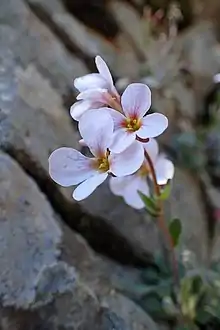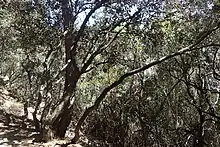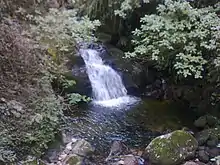Caledonia Waterfalls
Caledonia Waterfalls or Kalidonia Waterfalls, (Greek: Καταρράκτης των Καληδονιών Turkish: Kaledonya Şelalesi) is the Latin name given to the waterfalls discovered by a Scottish expedition visiting the Platres region of Cyprus in 1878. They ware surprised by the resemblance of the waterfall with their homeland and named them Caledonia which is an ancient Latin name of Scotland.[1]



Description
The water of the waterfall falls vertically from a height of 12 meters. According to the season, the surrounding area is covered in lush forest and native wild flowers. Avoiding the nature trail, some choose to walk through a shortcut from Aeodion road through the Psilo Dendro Trout Farm.[2] The trail can be followed from a parking area near the ‘Psilo Dendro’ (Tall Tree in Greek). Caledonia Falls can be enjoyed all year long, however, the rocky parts of the trail may be quite slippery after wet weather.[3][4] Hiking boots are recommended for crossing the river in wet weather or after snowfall.[5] Business Insider ranks the waterfall as the 14th Best waterfall in Europe.[6]
Location
The waterfalls are the highest in elevation found on the island and are located about 2 km north of Pano Platres village.[7] The official starting point is 3km from Troodos square.[8] Some tourists visit the area by using the roadway towards the waterfall or following the nature trail on foot leading to it through Psilo Dendro.[9] The nature trail can take between 1.5 and 2.5 hours to walk. It is ranked as average (Level:3) in difficulty.[10] The trail can be used for either hiking or walking but is best used from March until October. Dogs are able to use this trail as well.[11][12]
Etymology
A Scottish expedition saw a strong resemblance of the waterfall with their home land, (Scotland) and thus named them Caledonia - which is ancient Latin name of Scotland. The name of the Caledonians may be found in toponymy, such as Dùn Chailleann, the Scottish Gaelic word for the town of Dunkeld meaning "fort of the Caledonii", and possibly in that of the mountain Sìdh Chailleann, the "fairy hill of the Caledonians".[13][14] According to Historia Brittonum the site of the seventh battle of the mythical Arthur was a forest in what is now Scotland, called Coit Celidon in early Welsh.[15][16] The etymology is probably from a P-Celtic source. The modern use of "Caledonia" in English and Scots is either as a historical description of northern Britain during the Roman era or as a romantic name for Scotland as a whole.[16][17] Ptolemy's referred to the Caledonia Silva, recalled in the modern expression "Caledonian Forest", although the woods are reduced today compared to the Roman times. This association with a Silva (literally the flora) reinforces the idea that Caledonia was a forest or forested area named after the Caledonii.[18]
References
- "Kalidonia Waterfalls near Pano Platres (Cyprus)". www.waymarking.com. Retrieved 18 August 2019.
- "Caledonia Waterfalls (Kalidonia)". www.cyprusisland.net. Retrieved 5 September 2019.
- "Caledonia Waterfalls". www.AllTrails.com. Retrieved 5 September 2019.
- "Caledonia Hiking Trail & Waterfalls". www.ActivateCyprus.com. Retrieved 5 September 2019.
- "The Caledonia waterfall trail". www.Cyprus-Travel-Secrets.com. Retrieved 5 September 2019.
- "The 17 best waterfalls in Europe that tourists have never heard of". www.BusinessInsider.com. Retrieved 5 September 2019.
- "TCaledonia Waterfall". Google Maps. Retrieved 5 September 2019.
- "Kalidonia - Linear". www.Agrotourism.com.cy. Retrieved 5 September 2019.
- "5 PLACES IN CYPRUS TO SEE AUTUMN COLOURS". www.ChooseYourCyprus.com. Retrieved 5 September 2019.
- "Caledonia Waterfalls (Kalidonia)". www.cyprusisland.net. Retrieved 5 September 2019.
- "Caledonia Falls". mycyprustravel.com. Retrieved 5 September 2019.
- "Caledonia Waterfalls". tripadvisor.com. Retrieved 5 September 2019.
- Bennet 1985, p. 26.
- Watson 2004, p. 21.
- Lacy, Ashe & Mancoff 1997, p. 298.
- Koch 2006, p. 332.
- Keay & Keay 1994, p. 123.
- Smout, MacDonald & Watson 2007, pp. 20-25.
Bibliography
- Hanson, William S. (2003). "The Roman Presence: Brief Interludes". In Edwards, Kevin J.; Ralston, Ian B. M. (eds.). Scotland After the Ice Age: Environment, Archaeology and History, 8000 BC — AD 1000. Edinburgh University Press. ISBN 0-7486-1736-1.CS1 maint: ref=harv (link)
- Haverfield, Francis (1911). . In Chisholm, Hugh (ed.). Encyclopædia Britannica. 4 (11th ed.). Cambridge University Press. p. 987.CS1 maint: ref=harv (link)
- Keay, John; Keay, Julia (1994). Collins Encyclopaedia of Scotland. London: HarperCollins. ISBN 0-00-255082-2.CS1 maint: ref=harv (link)